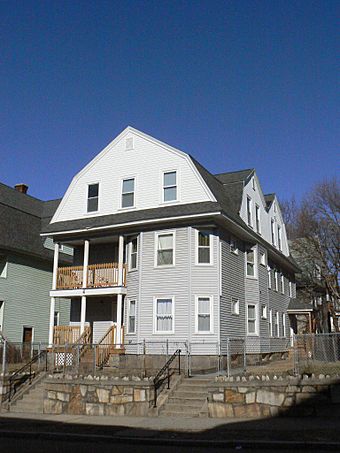Lars Petterson-James Reidy Three-Decker facts for kids
Quick facts for kids |
|
|
Lars Petterson-James Reidy Three-Decker
|
|

The Lars Petterson-James Reidy Three-Decker house
|
|
| Location | 4 Harlow St., Worcester, Massachusetts |
|---|---|
| Area | less than one acre |
| Built | c. 1910 |
| Architectural style | Colonial Revival |
| Added to NRHP | February 9, 1990 |
The Lars Petterson-James Reidy Three-Decker is a special historic house in Worcester, Massachusetts. It's called a "three-decker" because it has three floors, with one apartment on each floor. This type of house was very popular in New England.
This house was built around 1910 by Lars Petterson, who was a builder in the area. It's important because it was added to the National Register of Historic Places in 1990. This means it's recognized as a significant part of history. When it was listed, people noted its "Colonial Revival" style, which included square posts on the porches. Some of these original details have changed over the years.
About This Historic House
The Lars Petterson-James Reidy Three-Decker is located in the Brittan Square neighborhood of Worcester. You can find it on the north side of Harlow Street. It's a three-story building made of wood. The top floor has a unique roof shape called a gambrel roof. The outside of the house now has modern siding.
The front of the house isn't perfectly even. It has porches on the left side and a bay window (a window that sticks out) on the right. The porches on the first two floors have simple square posts. When experts looked at the house in the 1980s, the porches had more decorative posts and railings. The main roof also had fancy trim, and there was a small porch on the third floor tucked into an archway.
Who Lived Here?
Lars Petterson, the builder, owned this house until the 1920s. Then, he sold it to James Reidy, an electrician who also lived in the house.
Many of the first people who rented apartments here worked in local factories. Some worked at the Norton Company factory in northern Worcester. Others worked in the nearby steel and wire factories. These houses provided homes for many working families in the early 1900s.



